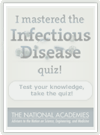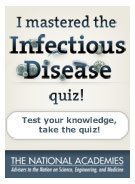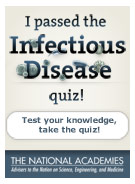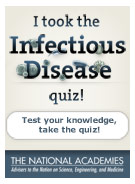
What You Need To Know About Infectious Disease
What do you know about infectious disease?
For each child who dies from pneumonia in an industrialized country, about how many children die from the infection in developing countries?
-
Sorry, that’s incorrect.
Life-saving vaccines and medications aren’t distributed equitably around the world; for each child who dies from pneumonia in an industrialized country, more than 2,000 children die from the infection in developing countries.
-
Sorry, that’s incorrect.
Life-saving vaccines and medications aren’t distributed equitably around the world; for each child who dies from pneumonia in an industrialized country, more than 2,000 children die from the infection in developing countries.
-
Sorry, that’s incorrect.
Life-saving vaccines and medications aren’t distributed equitably around the world; for each child who dies from pneumonia in an industrialized country, more than 2,000 children die from the infection in developing countries.
-
Correct!
Life-saving vaccines and medications aren’t distributed equitably around the world; for each child who dies from pneumonia in an industrialized country, more than 2,000 children die from the infection in developing countries.
Since the beginning of the 20th century, the number of people in the world has:
-
Sorry, that’s incorrect.
Since the beginning of the 20th century the number of people in the world has more than quadrupled—from 1.6 billion to nearly 7 billion—and world population is expected to rise to well over 9 billion by 2050.
-
Sorry, that’s incorrect.
Since the beginning of the 20th century the number of people in the world has more than quadrupled—from 1.6 billion to nearly 7 billion—and world population is expected to rise to well over 9 billion by 2050.
-
Correct!
Since the beginning of the 20th century the number of people in the world has more than quadrupled—from 1.6 billion to nearly 7 billion—and world population is expected to rise to well over 9 billion by 2050.
True or False: Scientists predict that rising average temperatures in some regions will change the transmission dynamics and geographic range of cholera, malaria, dengue fever, and tick-borne diseases.
-
Correct!
Scientists predict that rising average temperatures in some regions—a result of climate change—will change the transmission dynamics and geographic range of cholera, malaria, dengue fever, and tick-borne diseases.
-
Sorry, that’s incorrect.
Scientists predict that rising average temperatures in some regions—a result of climate change—will change the transmission dynamics and geographic range of cholera, malaria, dengue fever, and tick-borne diseases.
True or False: Growing evidence suggests that infections are behind many chronic diseases once thought to be caused by genetic, environmental, or lifestyle factors.
-
Correct!Growing evidence does suggest that infections are behind many chronic diseases once thought to be caused by genetic, environmental, or lifestyle factors, including peptic ulcers and cervical, liver, and gastric cancers.
-
Sorry, that’s incorrect.
Growing evidence does suggest that infections are behind many chronic diseases once thought to be caused by genetic, environmental, or lifestyle factors, including peptic ulcers and cervical, liver, and gastric cancers.
Which of the following is NOT a vector-borne disease?
-
Correct!
Influenza is not a vector-borne disease, meaning it is not transmitted to humans indirectly via an insect, an arthropod, or another animal. Malaria and yellow fever are transmitted by mosquitoes. Lyme disease is transmitted by deer ticks.
-
Sorry, that’s incorrect.
Influenza is not a vector-borne disease, meaning it is not transmitted to humans indirectly via an insect, an arthropod, or another animal. Malaria and yellow fever are transmitted by mosquitoes. Lyme disease is transmitted by deer ticks.
-
Sorry, that’s incorrect.
Influenza is not a vector-borne disease, meaning it is not transmitted to humans indirectly via an insect, an arthropod, or another animal. Malaria and yellow fever are transmitted by mosquitoes. Lyme disease is transmitted by deer ticks.
-
Sorry, that’s incorrect.
Influenza is not a vector-borne disease, meaning it is not transmitted to humans indirectly via an insect, an arthropod, or another animal. Malaria and yellow fever are transmitted by mosquitoes. Lyme disease is transmitted by deer ticks.
Of the more than 1,700 known viruses, bacteria, and other pathogens that infect people, how many have come from animals?
-
Sorry, that’s incorrect.
More than half of the known pathogens that infect people have come from animals. Of the 37 new infectious diseases identified in just the past 30 years, two-thirds sprang from animals.
-
Sorry, that’s incorrect.
More than half of the known pathogens that infect people have come from animals. Of the 37 new infectious diseases identified in just the past 30 years, two-thirds sprang from animals.
-
Correct!
More than half of the known pathogens that infect people have come from animals. Of the 37 new infectious diseases identified in just the past 30 years, two-thirds sprang from animals.
How many people in the world do not have access to an adequate water supply?
-
Sorry, that’s incorrect.
Worldwide, 884 million people do not have access to an adequate water supply, and about three times that number lack basic sanitation services. An estimated 2 million deaths a year can be attributed to unsafe water supplies.
-
Sorry, that’s incorrect.
Worldwide, 884 million people do not have access to an adequate water supply, and about three times that number lack basic sanitation services. An estimated 2 million deaths a year can be attributed to unsafe water supplies.
-
Correct!
Worldwide, 884 million people do not have access to an adequate water supply, and about three times that number lack basic sanitation services. An estimated 2 million deaths a year can be attributed to unsafe water supplies.
Which of the following is not a viral disease:
-
Sorry, that’s incorrect.
Trichinosis is not a viral disease. It is caused by a helminth (parasitic worm) found in undercooked meat, not by a virus.
-
Sorry, that’s incorrect.
Trichinosis is not a viral disease. It is caused by a helminth (parasitic worm) found in undercooked meat, not by a virus.
-
Correct!
Trichinosis is not a viral disease. It is caused by a helminth (parasitic worm) found in undercooked meat, not by a virus.
How many people in the United States die from flu-related complications each year?
-
Sorry, that’s incorrect.
About 36,000 people die from flu-related complications each year in the United States. More than 200,000 are hospitalized.
-
Correct!
About 36,000 people die from flu-related complications each year in the United States. More than 200,000 are hospitalized.
-
Sorry, that’s incorrect.
About 36,000 people die from flu-related complications each year in the United States. More than 200,000 are hospitalized.
Thank you for taking our quiz.
Place this badge on your Facebook page to show your friends what you know about infectious disease.
Place this badge on your Facebook page to show your friends what you know about infectious disease.
OR, get a higher score to unlock a different badge.

Place this badge on your Facebook page to show your friends what you know about infectious disease.
OR, get a higher score to unlock a different badge.

Explore Other Topics
Disease Watchlist
Infectious Disease Defined
- Protozoa
A taxonomic group of single-celled microorganisms that live in almost every kind of habitat and include some pathogenic parasites of humans and other animals.


